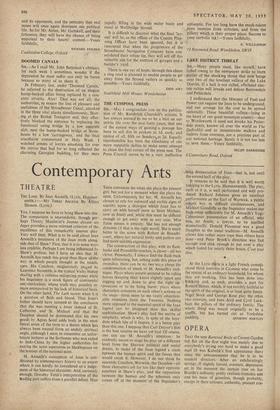Contemporary Arts
THEATRE
'YES, I suppose we have to bring Shaw into this The comparison is unavoidable, though per- haps Thierry Maulinier's Jeanne devout ses Juges provides a more relevant criterion of the excellence of this remarkably uneven play Very well then. What is to be said about Jean Anouilh's treatment of the Joan myth along- side that of Shaw? First, that it is in some ways leis credible. Perhaps I am being influenced by Shaw's preface, but I have an idea that M. Anouilh has much less graip than Shaw of the way in which people thought in the middlt. ages. His. Cauchon, magisterially plaxed by Laurence Naismith, is the typical Vichy bishop dealing with a ruthless occupying power while his Inquisitor is a stock figure of continental anti-clericalism, whose truth may possibly re- main unimpaired by his lack of historical basis. Qn the other hand, The Lark scores when it is a question of flesh and blood. That Joan's father should have jumped- tb the conclusion that she was meeting a lover instead of St. Catherine and St. Michael and that the Dauphin should be dominated (for his own good) by Agnes Sorel adds body in the most literal sense of the term to a theme which bas always been treated from an unduly spiritual angle, although I seem to remember an unfor- tunate lecturer at the Sorbonne who was exiled to Indo-China' by the higher authorities for casting the same aspersions as Shakespeare on the honour of the national saint.
M. Anouilh's conception of Joan is con- ditioned by contemporary history to an extent where it can hardly be considered as'a judge- ment of the historical character. And, curiously enough, Dorothy Tutin's interpretation of the leading part suffers from a parallel defect. Miss Tulin convinces me when she plays the peasant girl, but not for a moment when she plays the saint. Unfortunately for her, M. Anouilh has chosen to rely for outward and visible signs of sanctity upon a dialogue which Joan has to carry on with herself (now as Saint Michael, now as Joan) and, while this must be difficult enough to get away with in any case, Miss rutin misses it entirely. She has not enough dynamic (if that is the right word). She is much better in the scene with Robert de Bcaudri- court, where her natural levity and pathos can find more suitable expression.
The construction of this play, with its flash- backs and Pirandello touches, is clever—all too clever. Personally, I always find the flash-back quite infuriating, hut, setting aside this piece of prejudice, there can he no two ways about the condemnation of much of M. Anouilh's tech- nique. Plays where people pretend to be riding horses (keeping their knees slightly apart and jogging up and down to give the right im- .4 pression) or to be being burnt; plays where characters comment on each other's actions on the stage—these seem to me vastly objection- able remnants from the Twenties. Nothing more opposed to the essential spirit of the Joan legend can be imagined than this skilful sophistication. Shaw's play had the merits of simplicity, which is why, in spite of the bore- dom which bits of it inspire, it is a better play than this one. I supposp that Carl Dreyer's film is the best version we have yet had. Of course, one can see M. Anouilh's intention ; he evidently meant to stage his play on a different level from the Shavian political and social drama, to make of the Joan legend a clash between the human spirit and the forces that would crush it. However, I do not think he succeeds. Cauchon, Warwick, the Dauphin—all these characters are far too like their opposite numbers in Shaw's play, and the opposition between the human and the inhuman only comes off at the moment of the InqUisitor's long denunciation of Joan—that is, not until the second half of the play.
It remains to be said that it is well worth trekking to the Lyric, Hammersmith. The play, such as it is, is well performed and well pro- duced. Richard Johnson gives an excellent performance as the Earl of Warwick, a public school boy in difficult circumstances, and Michael Goodliffe as the Inquisitor makes our flesh creep sufficiently for M. Anouilh's Yogi- Commissar presentation of an official, who was, no doubt, a lawyer, to be justified dramatically. Donald Pleasence was a good Dauphin in the usual tradition—M. Anouilh allows him rather more rope than others have done—and Peter Brook's direction was fast enough and slick enough to put over a play which lasted for nearly three hours. C'est tout dire.
* ,
At the Lyric titre is a light French cometily about three convts in Cayenne who come to the rescue of an ordinary household, for whom they arc working. This has been done into cockney and, as such, provides a part for Ronald Shiner, which, if not terribly faithful to the spirit of the original, is at least quite funny. Nigel Stock and George Rose play the other two convicts, and Jane Aird and Cyril Luck- ham the pillars of the ordinary family. The whole thing was meant originally to be a souffid, but has turned out as Yorkshire










































 Previous page
Previous page